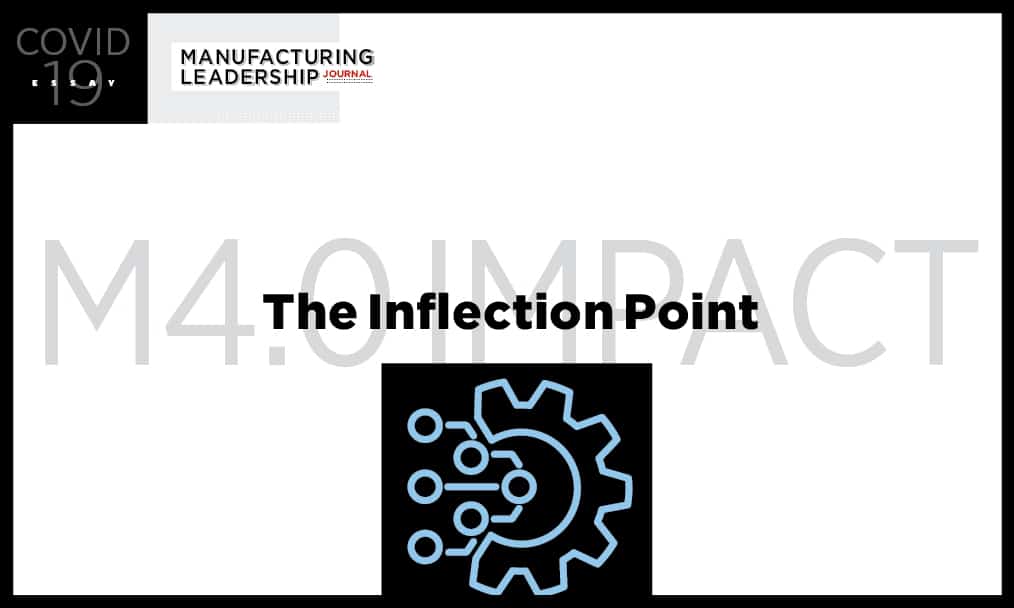
The adoption of Manufacturing 4.0 will likely accelerate as a result of the pandemic.
Even before the COVID-19 virus arrived, there was mounting evidence that the adoption of Manufacturing 4.0 digitization was moving too slowly in many U.S. manufacturing companies. MLC survey research had been showing for years an almost glacial-like pace of acceptance as companies grappled with legacy systems issues, organizational and cultural changes, and a lack of digital acumen on leadership benches.
Other countries, notably Germany, where the Industry 4.0 concept was born in 2011, and some in the Asia-Pacific region seemed to be moving ahead more aggressively. A McKinsey/World Economic Forum study of so-called digital “Lighthouse” factories revealed that of 44 advanced installations identified worldwide, only three were in the U.S.
But when the pandemic hit and so quickly tested the flexibility of companies to react and in some cases pivot production, it became clear almost overnight that the companies that had embraced the digital model were in a far better position to manage through the crisis than those that did not or that hadn’t done enough.
“Every advancement right now in digital is what has allowed us not just to survive, but to thrive,” says Michele D’Alessandro, Vice President and Chief Information Officer, Manufacturing IT, at Merck & Co., Inc., and a member of the MLC’s Board of Governors.
The Link to Recovery
As the nation begins what looks like will be a slow and arduous recovery from the economic shock inflicted by the virus, the value and importance of the digital model in not only enabling adaptability but in also facilitating the resumption of operations in those companies that have been idled appears to have reached an important inflection point. The pandemic may have dealt a death blow to any lingering doubts about the road to the future and the need for speed in getting there.
The first order of business for many, though, will be financial stabilization and ensuring employees feel safe to return to work. After those hurdles are cleared, the race for digital advantage will move into higher gear.
“Every company’s circumstances are different,” says Gerald Johnson, Executive Vice President of Global Manufacturing, at General Motors. “The cost of conversion is different; M4.0 is not a one-size fits all. But the only question is velocity, not destination.”
Adds Janice Abel, a Principal Consultant at ARC Advisory Group: “Even people who thought M4.0 was years away will no longer believe that.”
In some ways, the pandemic has underscored a kind of sociological split around the digital model that has existed in manufacturing for a number of years. The split can be thought of as the gap between those that embraced the digital model and those that did not, what Kevin Prouty, Group Vice President at IDC Manufacturing Insights, calls the “digital divide”.
Once the pandemic’s smoke clears, the race for digital advantage will move into high gear.
For those that did not, the pandemic should be a loud wake-up call. Among its key messages, Prouty says, is that generally higher revenues and profit margins attend those that have embraced the digital model, And in the new operating environment spurred by the pandemic, one in which safety is being redefined to include the necessity of social distancing and the advantages to be accrued by managing operations remotely, the digital model is mandatory.
“There is going to be an initial retrenching, but even in the worst industries, in nine to 12 months, there is going to be more investment in digital technologies on a use-case basis,” Prouty predicts.
Those investments, either new or accelerated, says Abel of ARC, will include cloud adoption for critical applications, remote working where feasible, tools like digital dashboards, robotic systems, and analytics and artificial intelligence as companies move faster to reap the benefits of being data-driven organizations.
“Being more flexible and agile is the future,” she says.
How and at what pace we get to the digital promised land is, of course, the question for our time. Some are predicting that the pandemic has forever altered things, that a so-called new normal is emerging that will result in changed behaviors, a fundamental rethink of business models, and even the employee/employer relationship. McKinsey, for example, is advocating that companies focus on four strategic areas: recovering revenue, rebuilding operations, rethinking the organization, and accelerating the adoption of digital solutions.
The Leadership Challenge
But human nature, being what it is, doesn’t always act logically. There is a risk that once the pandemic storm passes, people and organizations will revert to the familiar, more secure in past behavior than in what the future may demand. The challenge, and opportunity, for leadership is to imprint the moment in our corporate consciousness and DNA, to turn the page and truly write a new chapter in the annals of manufacturing history.
It is passing strange that it sometimes takes a cataclysmic event to enable change. Perhaps when we look back years from now the year 2020 will be seen as one of those events, one of those clarifying and unifying moments when the path forward became crystal clear. Will the industry have the stamina, strength, and courage to walk down that road en masse? M